A Novel Method Based on Multi-Island Genetic Algorithm Improved Variational Mode Decomposition and Multi-Features for Fault Diagnosis of Rolling Bearing
Abstract
1. Introduction
2. Brief Introduction of VMD
2.1. Construction of the Variational Problem
2.2. Solving the Variational Problem
3. Parameter Optimization Based on Multi-Island Genetic Algorithm
4. Holder Coefficient
5. Multi-Features
5.1. Renyi Entropy Feature
5.2. Singular Value Feature
5.3. Hjorth Parameters Feature
5.3.1. Activity Parameter
5.3.2. Mobility Parameter
5.3.3. Complexity Parameter
6. Fault Diagnosis Model Based on MIGA-VMD and Multi-Features
7. Experimental Verification and Result Analysis
7.1. Introduction of Experiment
7.2. Comparison and Analysis of MIGA-VMD Decomposition Effect
7.3. Comparison and Analysis of Feature Extraction
7.4. Comparison and Analysis of Fault Diagnosis Accuracy
8. Conclusions
- (1)
- Through the envelope spectrum analysis, the MIGA-VMD method can extract the fault feature information of the signal more effectively and significantly than EMD and EEMD, which is of great significance for the fault diagnosis of rolling bearings.
- (2)
- Through t-SNE dimensionality reduction visualization analysis, compared with the permutation entropy feature, sample entropy feature, and energy entropy feature, the multi-features composed of Renyi entropy feature, singular value feature, and Hjorth parameter feature can more accurately characterize the fault information of the bearing signal and effectively improve the accuracy of fault recognition.
- (3)
- The MIGA-VMD decomposition and multi-features feature extraction method is combined with three classifiers respectively to establish new fault diagnosis models. Through experimental comparison and analysis, the new fault diagnosis models have high recognition accuracy, which verifies the superiority of the method proposed in this paper.
Author Contributions
Funding
Conflicts of Interest
References
- Zhang, J.; Zhang, J.Q.; Zhong, M.; Zheng, J.D.; Li, X.K. PSO-VMD-MCKD Based fault diagnosis for incipient damage in wind turbine rolling bearing. J. Vib. Meas. Diag. 2020, 40, 287–296. [Google Scholar]
- Gai, J.B.; Shen, J.X.; Hu, Y.F.; Wang, H. An integrated method based on hybrid grey wolf optimizer improved variational mode decomposition and deep neural network for fault diagnosis of rolling bearing. Measurement 2020, 162, 107901. [Google Scholar] [CrossRef]
- Wang, C.H.; Cai, J.H.; Zeng, J.S. Research on fault diagnosis of rolling bearing based on empirical mode decomposition and principal component analysis. Acta Metrol. Sin. 2019, 40, 1077–1082. [Google Scholar]
- Zhou, C.; Wu, X.; Liu, C.; He, W. Rolling bearing fault diagnosis based on EMD and fuzzy c means clustering. J. Kunming Univ. Sci. Technol. (Sci. Technol.) 2009, 34, 34–39. [Google Scholar]
- Wu, Z.; Huang, N.E. Ensemble empirical mode decomposition: A noise-assisted data analysis method. Adv. Adapt. Data Anal. 2009, 01, 1–41. [Google Scholar] [CrossRef]
- Xu, L.; Yu, R.X.; Xing, B.S.; Chen, H.F.; Lang, C.N. Fault feature extraction for rolling bearing based on LMD energy entropy. Mech. Transm. 2019, 43, 136–139. [Google Scholar]
- Dragomiretskiy, K.; Zosso, D. Variational mode decomposition. IEEE Trans. Signal Process 2014, 62, 531–544. [Google Scholar] [CrossRef]
- Liu, J.C.; Quan, H.; Yu, X.; He, K.; Li, Z.H. Rolling bearing fault diagnosis based on parameter optimization VMD and sample entropy. Acta Autom. Sin. 2019, 1–12. [Google Scholar] [CrossRef]
- Liu, C.L.; Wu, Y.J.; Zhen, C.G. Rolling bearing fault diagnosis based on variational mode decomposition and fuzzy C means clustering. Proc. CSEE 2015, 35, 3358–3365. [Google Scholar]
- Ding, C.J.; Zhang, L.; Feng, Y.B.; Fu, X.Y. Fault diagnosis method of rolling bearing combining VMD with t-SNE. Mech. Sci. Technol. Aerosp. Eng. 2020, 39, 758–764. [Google Scholar]
- Dou, D.Y.; Li, L.J.; Zhao, Y.K. Fault diagnosis of rolling bearings using EEMD- Renyi entropy and PCA-PNN. J. Southeast Univ. (Nat. Sci. Ed.) 2011, 41, 107–111. [Google Scholar]
- Li, D.; Liu, G.P.; Huang, J.Y.; Zhang, A.A. Fault diagnosis of bearing based on EEMD-SVD and SVM. Mach. Des. Res. 2019, 35, 123–127. [Google Scholar]
- Zhou, Z. Structural Optimization of Wave-Tape Inserted into Heat Transfer Tube Based on Multi-Island Genetic Algorithm. Master’s Thesis, Huazhong University of Science and Technology, Wuhan, China, 2019. [Google Scholar]
- Ma, H.; Tong, Q.; Zhang, Y. Application of variational modal decomposition of optimized parameters in fault diagnosis of rolling bearings. China Mech. Eng. 2018, 29, 390–397. [Google Scholar]
- Zhang, C.; Wang, Y.; Deng, W. Fault diagnosis for rolling bearings using optimized variational mode decomposition and resonance demodulation. Entropy 2020, 22, 739. [Google Scholar] [CrossRef]
- Tang, G.J.; Wang, X.L. Parameter optimized variational mode decomposition method with application to incipient fault diagnosis of rolling bearing. J. Xi’an Jiaotong Univ. 2015, 49, 73–81. [Google Scholar]
- Li, J. A new robust signal recognition approach based on Holder cloud features under varying SNR environment. KSII Trans. Internet Inf. Syst. 2015, 9, 4934–4949. [Google Scholar]
- Li, J. A novel recognition algorithm based on Holder coefficient theory and interval gray relation classifier. KSII Trans. Internet Inf. Syst. (TIIS) 2015, 9, 4573–4584. [Google Scholar]
- Li, J.C.; Ying, Y.L.; Ren, Y.; Xu, S.Y.; Bi, D.Y.; Chen, X.Y.; Xu, Y.F. Research on rolling bearing fault diagnosis based on multi-dimensional feature extraction and evidence fusion theory. R. Soc. Open Sci. 2019, 6. [Google Scholar] [CrossRef]
- Peng, J.; Wang, W.Q.; Wang, H.Y.; Tang, X.A. Fault diagnosis method of wind turbine’s bearing based on EEMD kurtosis-correlation coefficients criterion and multiple features. Renew. Energy Resour. 2016, 34, 1481–1490. [Google Scholar]
- Wu, H.S.; Lv, J.X.; Lai, L.H.; Wu, L.S.; Zhu, Y.R. Fault pattern recognition of rolling bearing based on EMD-SVD model and SVM. Noise Vib. Control 2011, 31, 89–93. [Google Scholar]
- Hjorth, B. EEG analysis based on time domain properties. Electroencephalogr. Clin. Neurophysiol. 1970, 29, 306–310. [Google Scholar] [CrossRef]
- Grover, C.; Turk, N. Rolling element bearing fault diagnosis using empirical mode decomposition and hjorth parameters. Procedia Comput. Sci. 2020, 167, 1484–1494. [Google Scholar] [CrossRef]
- Ben Ali, J.; Fnaiech, N.; Saidi, L.; Chebel-Morello, B.; Fnaiech, F. Application of empirical mode decomposition and artificial neural network for automatic bearing fault diagnosis based on vibration signals. Appl. Acoust. 2015, 89, 16–27. [Google Scholar] [CrossRef]
- Yan, X.; Jia, M. A novel optimized SVM classification algorithm with multi-domain feature and its application to fault diagnosis of rolling bearing. Neurocomputing 2018, 313, 47–64. [Google Scholar] [CrossRef]

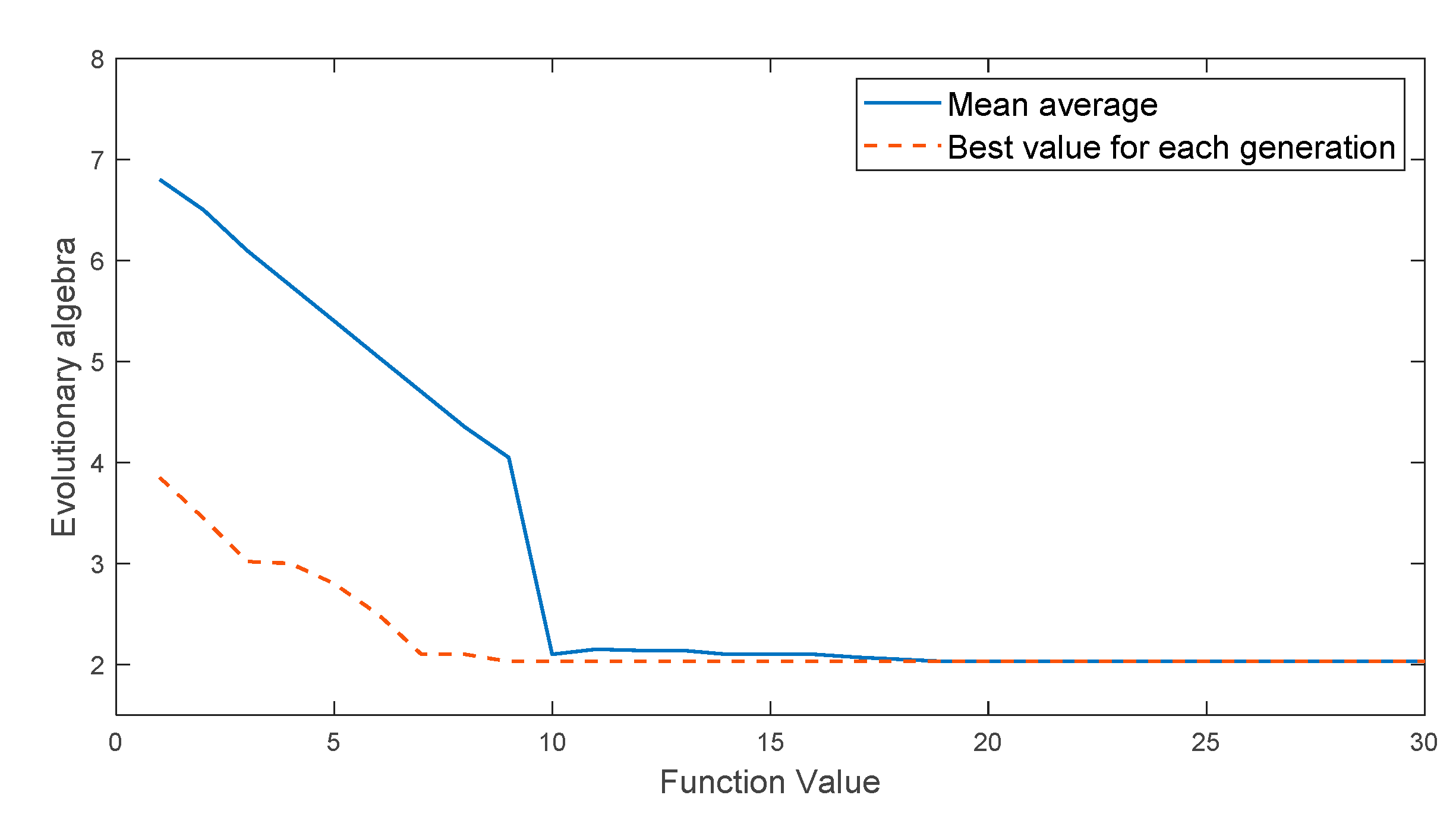


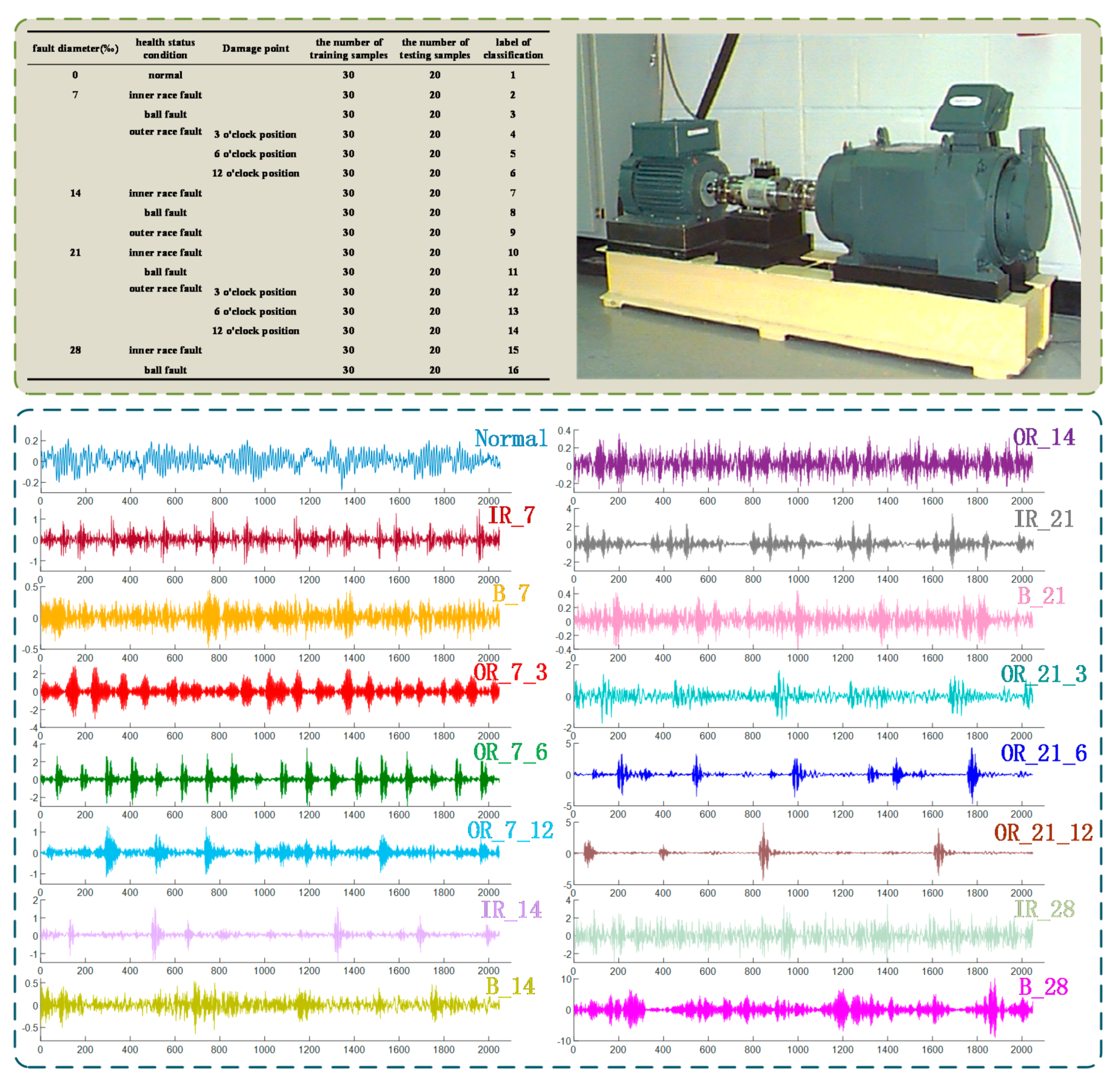



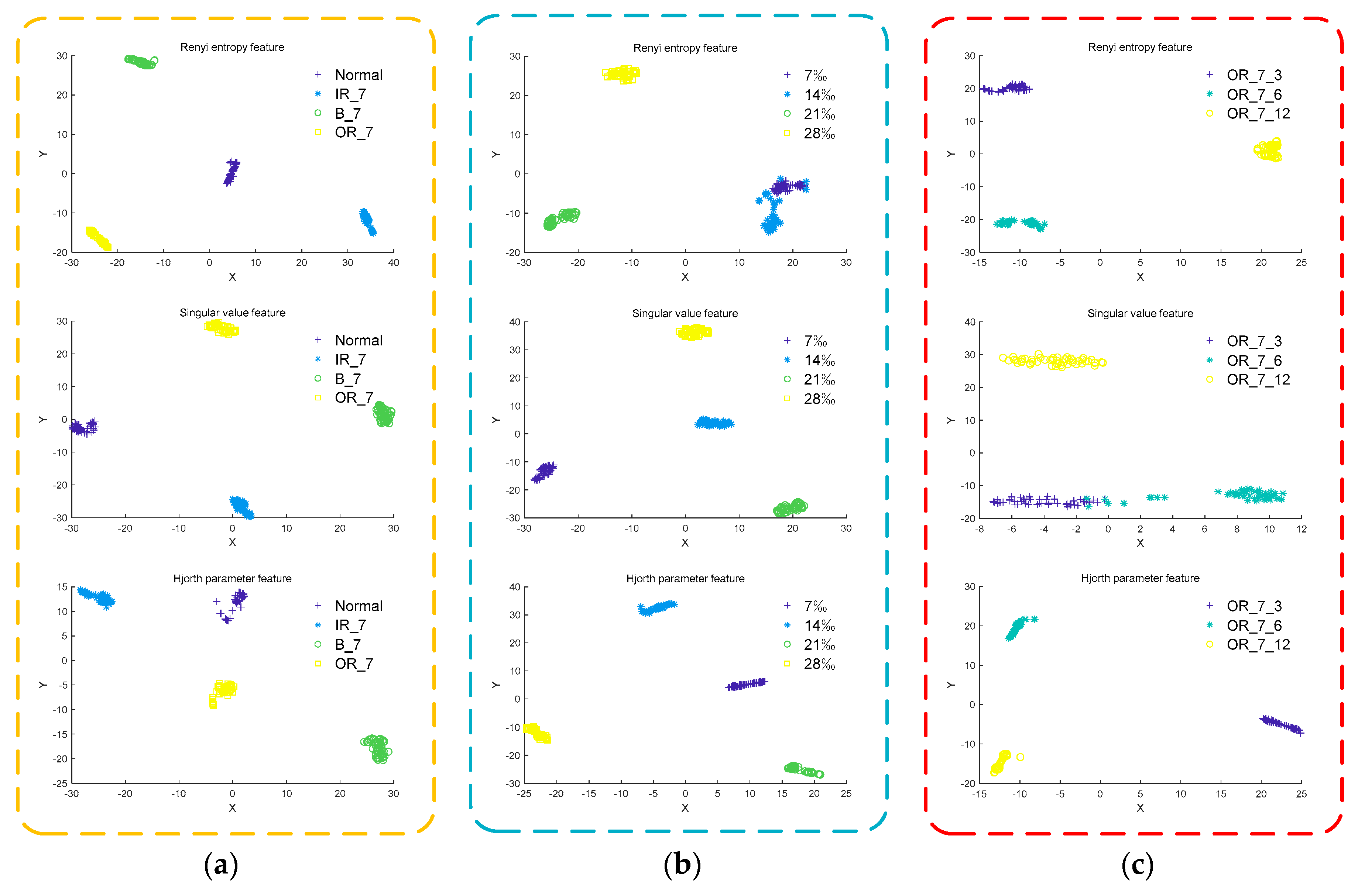
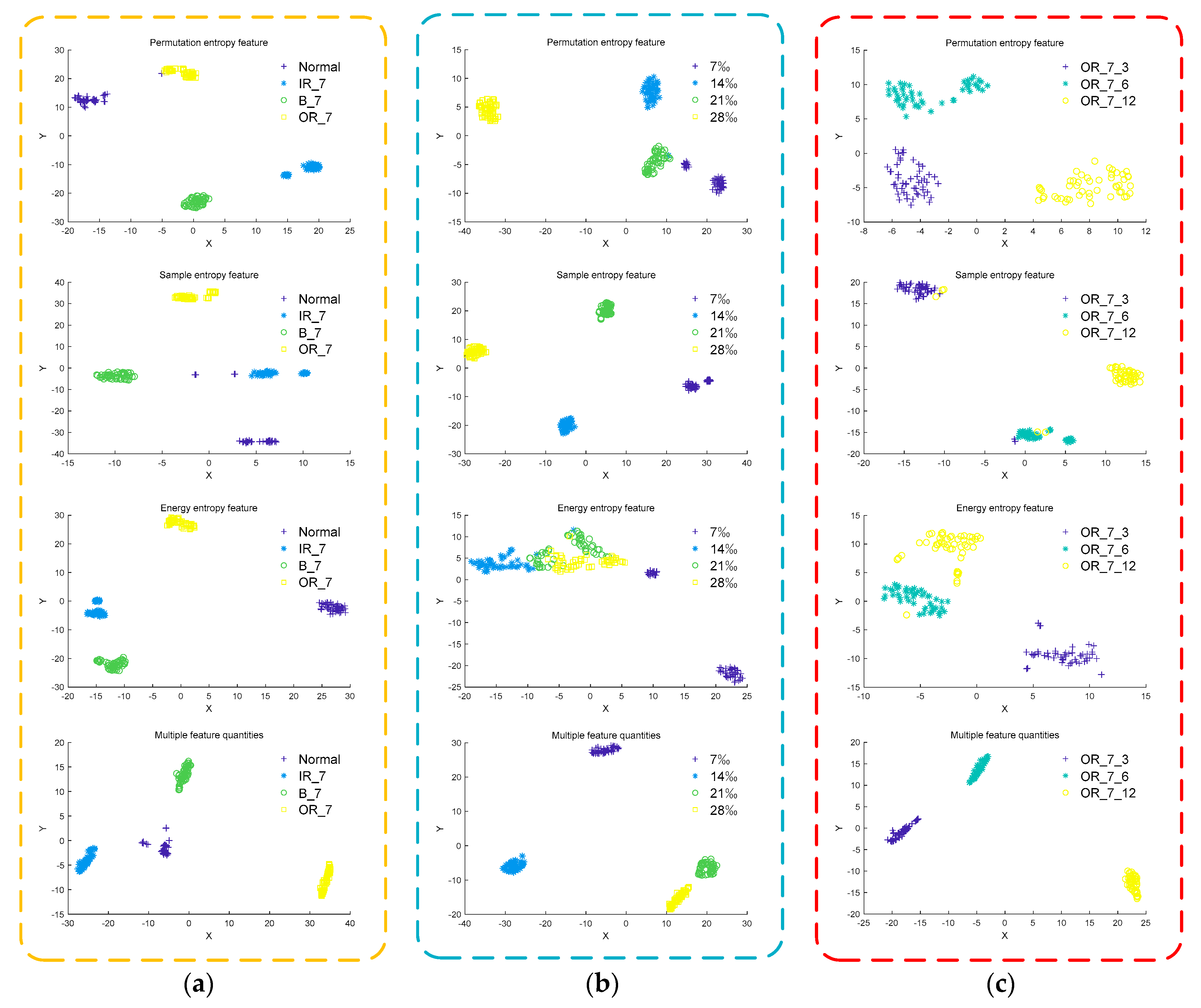
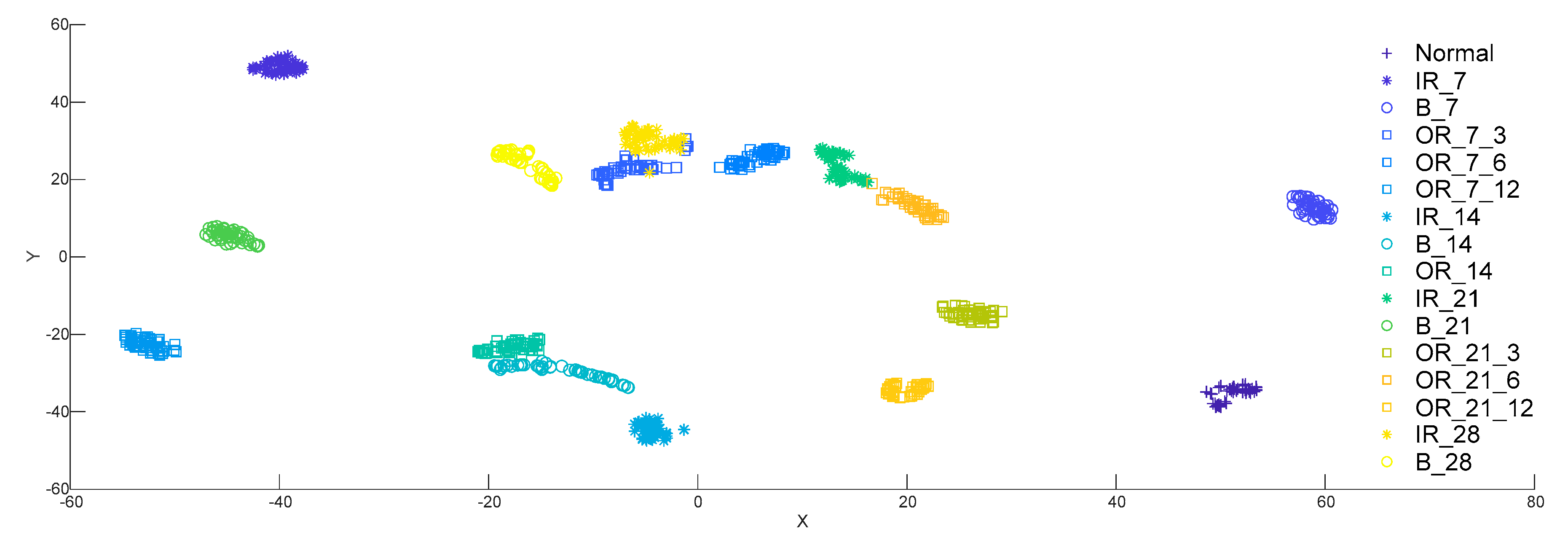

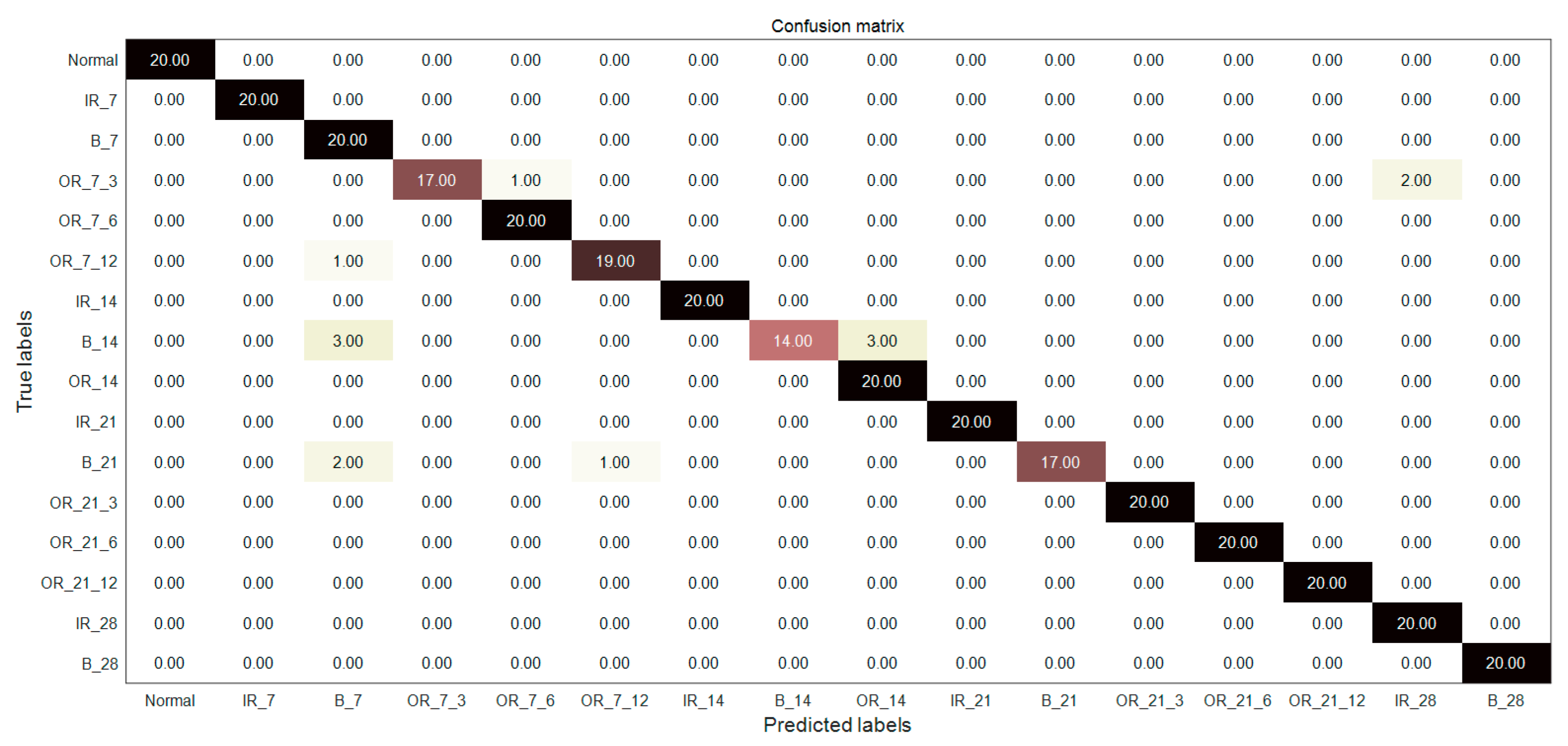
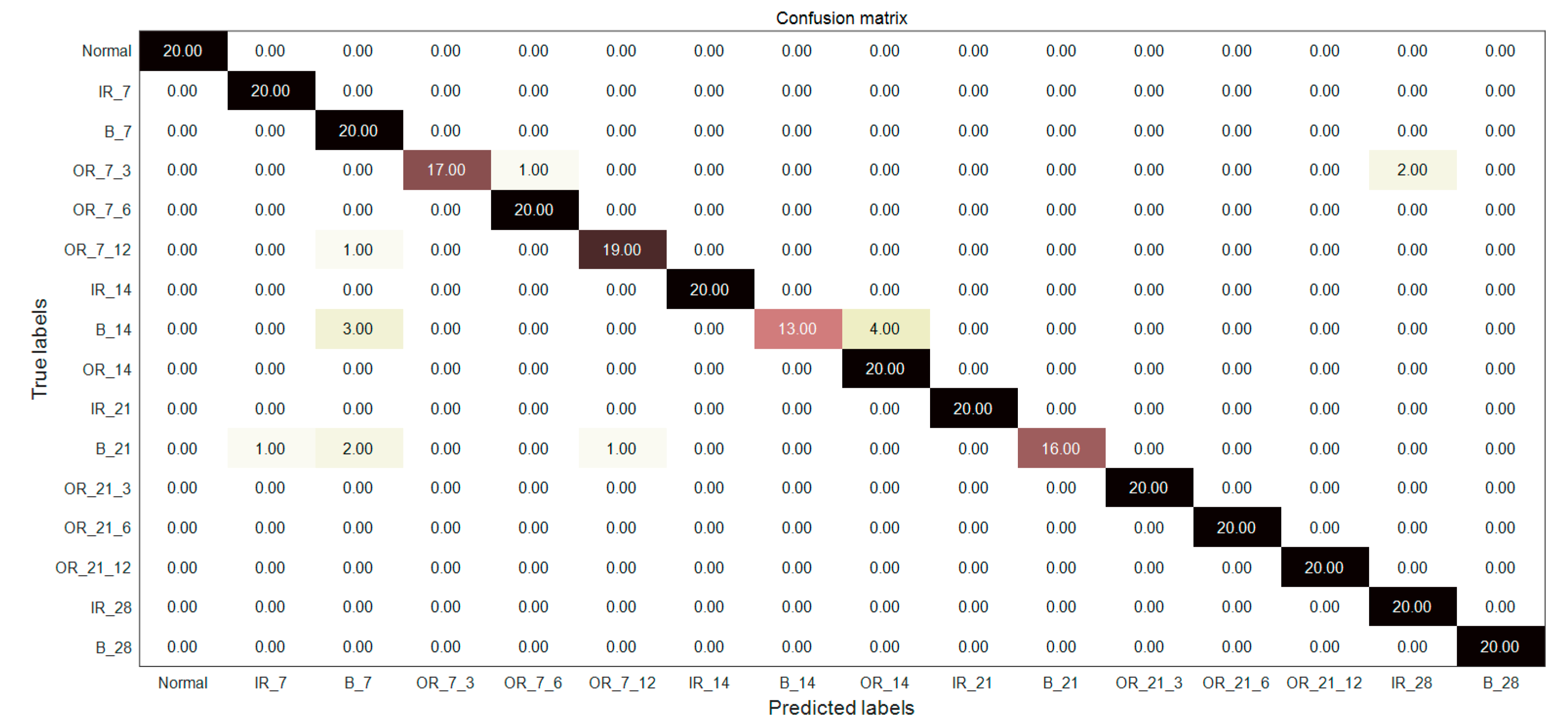
| Algorithm: multi-island genetic algorithm |
|---|
| Step1: Initialize population . Step2: The initial population is divided into multiple “islands”, namely subpopulations. Step3: Calculate the fitness value of each individual on each “island”. Step4: The selection, crossover, and mutation operations in the standard genetic algorithm are performed on each island. Step5: If the migration conditions are met, then migrate from one island to another. Step6: If the current number of iterations is less than the maximum number of iterations MaxGen, then proceed to Step3, otherwise proceed to Step7. Step7: The individual with the best fitness value in the output population is the optimal solution. |
| Health Status Condition | Health Status Condition | ||
|---|---|---|---|
| Normal | [12,94] | OR_14 | [14,510] |
| IR_7 | [10,151] | IR_21 | [15,2519] |
| B_7 | [14,248] | B_21 | [14,1246] |
| OR_7_3 | [13,935] | OR_21_3 | [13,3987] |
| OR_7_6 | [15,3876] | OR_21_6 | [14,3419] |
| OR_7_12 | [14,921] | OR_21_12 | [13,1065] |
| IR_14 | [9,3241] | IR_28 | [15,3968] |
| B_14 | [14,576] | B_28 | [14,678] |
| Literature | Feature | Classifier | No. of Classes | Accuracy |
|---|---|---|---|---|
| [23] | EMD Hjorth parameter features | Rule-based classifiers | 4 (N, IR, B, OR) | 93.82% |
| This Work | MIGA-VMD-multi-features | Rule-based classifiers | 16 | 94.68% |
| [24] | EMD energy entropy of the first seven IMFs and classical statistical features | ANN | 7(H, DR, FR, DIR, FIR, DOR, FOR) | 93% |
| This Work | MIGA-VMD-multi-features | ANN | 16 | 96.25% |
| [25] | 16 Time domain +13 Frequency domain + 8 Time-frequency domain features | PSO-SVM | 12(N, IR7, IR14, IR21, IR28, OR7, OR14, OR21, B7, B14, B21, B28) | 93.33% with time-domain features |
| This Work | MIGA-VMD-multi-features | PSO-SVM | 16 | 95.31% |
© 2020 by the authors. Licensee MDPI, Basel, Switzerland. This article is an open access article distributed under the terms and conditions of the Creative Commons Attribution (CC BY) license (http://creativecommons.org/licenses/by/4.0/).
Share and Cite
Liang, T.; Lu, H. A Novel Method Based on Multi-Island Genetic Algorithm Improved Variational Mode Decomposition and Multi-Features for Fault Diagnosis of Rolling Bearing. Entropy 2020, 22, 995. https://doi.org/10.3390/e22090995
Liang T, Lu H. A Novel Method Based on Multi-Island Genetic Algorithm Improved Variational Mode Decomposition and Multi-Features for Fault Diagnosis of Rolling Bearing. Entropy. 2020; 22(9):995. https://doi.org/10.3390/e22090995
Chicago/Turabian StyleLiang, Tao, and Hao Lu. 2020. "A Novel Method Based on Multi-Island Genetic Algorithm Improved Variational Mode Decomposition and Multi-Features for Fault Diagnosis of Rolling Bearing" Entropy 22, no. 9: 995. https://doi.org/10.3390/e22090995
APA StyleLiang, T., & Lu, H. (2020). A Novel Method Based on Multi-Island Genetic Algorithm Improved Variational Mode Decomposition and Multi-Features for Fault Diagnosis of Rolling Bearing. Entropy, 22(9), 995. https://doi.org/10.3390/e22090995






